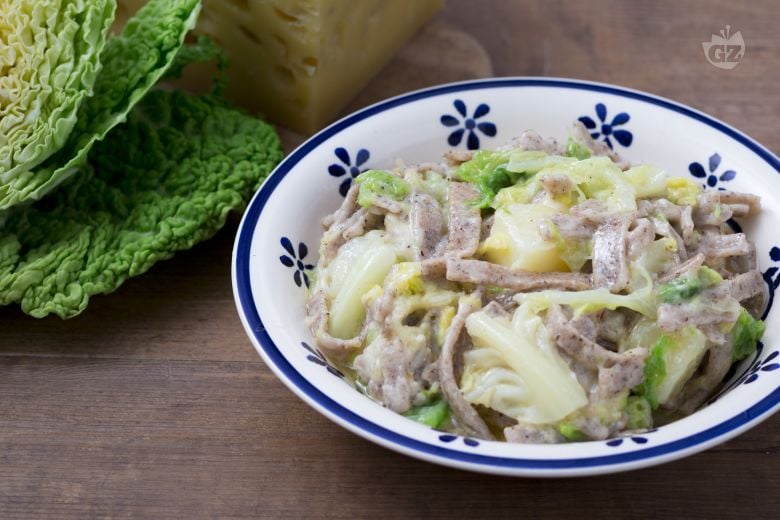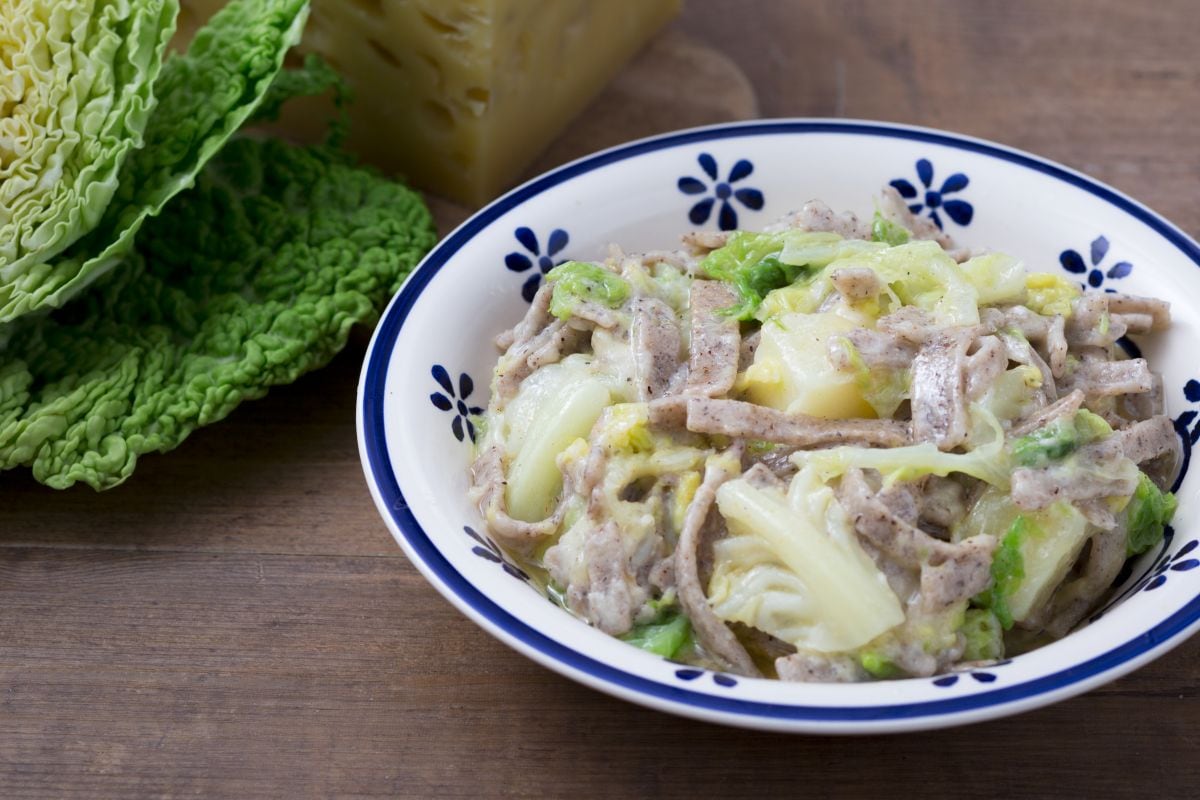Stuffed Tagliatelle
- Average
- 1 h 20 min


There are genuine and hearty dishes that will warm your belly and heart, especially at high altitude! If you are in Valtellina, in particular in the small town of Teglio, you cannot but taste the pizzoccheri. Beware of imitations, however: although it is a dish of humble origins, pizzoccheri pasta is a dish whose goodness comes not only from the processing of ingredients, but also from their selection: stone-ground buckwheat flour, cabbage from the garden, alpine butter are some of the must-haves to leave your guests really amazed. At Giallozafferano we too relied on a chef from Valtellina, Alessandro Negrini, an expert in this rustic dish from an early age, when his grandmother made it. Following in the footsteps of tradition, you can make this rich and enjoyable dish, in the summer or winter, by starting with the pizzoccheri, a pasta shape similar to tagliatelle but shorter, made of buckwheat flour, type 0 flour and water. To discover all the authentic taste of this first course, follow the steps and suggestions for cooking and sharing a fabulous hot and stringy pizzoccheri pasta dish!

To prepare the pizzoccheri, start by pouring the 0 flour and the buckwheat flour in the indicated doses into a bowl 1, mix the two flours well 2 and add the water at a temperature of 125° F (50° C) 3. This will make the buckwheat starches amalgamate more easily.

Start kneading the ingredients by hand in the bowl 4, transfer everything to a pastry board lightly floured with buckwheat flour 5 and knead the dough vigorously 6. This stage of work is crucial: the dough must be handled with care to obtain a consistency as elastic as possible.

Form a ball 7; the consistency should be silky, not too soft. Flatten the ball of dough sprinkled with a little buckwheat flour 8 and start rolling out the dough with a rolling pin to a thickness of about 1/10 in (2-3 mm) 9.

Now, trim the edges 10 to even it out and form a rectangle, lightly sprinkle the surface with more buckwheat flour 11 and cut with a sharp knife into strips about 2.75 in (7 cm) wide 12.

If necessary, overlap 3 strips one on top of the other 13, sprinkling them with a little buckwheat flour 14; this method makes it faster to obtain the pizzoccheri pasta correctly, cutting the overlapping strips into slices about 1/2 in. (0.5-1 cm) thick. Set the first pizzoccheri obtained aside, then continue in the same way with the rest of the dough 15. The previously discarded scraps can be used to prepare a delicious potato soup!

Start preparing the seasoning by putting a pot with 6.3 quarts (6 liters) of water to boil; in the meantime, clean the cabbage, peel off the outer leaves (you can make a soup with them), cut it in half, then cut it into slices 16, remove the leathery part 17 and reduce the cabbage to slices 18.

Then move on to the potatoes: peel them and cut them into thick slices, then into rather large pieces; just try to make the pieces of uniform size 19 for the cooking to be homogeneous. When the water boils, add 3 tbsp (60 g) of salt (1/2 tbsp (10 g) per liter). Boil the potatoes alone for about 2 minutes 20. Meanwhile, thinly slice the dairy cheese (preferably at room temperature) 21.

After two minutes of cooking the potatoes, add the cabbage 22; it is very important that the vegetables cook inside the water 23 in which the pizzoccheri pasta will cook because this helps balance the substances that end up on your plate, both nutritious and digestive. After about 4 minutes you can add half the pizzoccheri pasta, slowly dropping them into the pot 24;

using the handle of a wooden ladle, turn them gently 25, to prevent them from sticking, then slowly add the remaining half. Stir a few more moments, and again while the pizzoccheri is cooking (they will have to cook for about 4 minutes). Cut the unpeeled garlic cloves in half 26 then pour the butter into a pan and melt it together with the garlic cloves 27;

the butter must melt and get seasoned with garlic 28 so leave it on the heat at medium-low until it becomes hazelnut colored. In the meantime, prepare a large low pan where you will later drain and season the pizzoccheri pasta once ready. You will need to heat this empty pan by balancing it on the pot 29 with the pizzoccheri; this will allow the cheese to melt in a homogeneous and controlled manner. Then lower the heat under the pizzoccheri pot without turning it off. Using a skimmer, start draining the pizzoccheri pasta very well 30

so as not to transfer any water into the pan that you have heated, and make a first layer on the bottom of the pan 31. Without mixing anything in the process, now distribute a layer of Dairy cheese 32 and continue with another layer of pizzoccheri pasta; repeat the layer of the Latteria cheese again and continue until you finish with the last layer of pizzoccheri pasta and cheese. Flavored with grated Grana cheese 33

and, at this point, follow the example of the Valtellina grandmothers: place the pan with the pizzoccheri on top of the one with the cooking water still hot, just to keep it warm 34. Cover with a cloth 35: this way the warmth of the pizzoccheri, cabbage and potatoes will help the cheese to melt. In the meantime, turn up the heat under the pan with the melted butter and garlic, until obtaining the hazelnut color as previously mentioned. This will add flavors to the dish, without affecting its digestibility. Then pour the hot butter over the pizzoccheri 36, you will see that the cheese has already melted;

remove the cloves of garlic 37 and stir the pizzoccheri gently and not too much 38; plate 39 and enjoy the pizzoccheri hot and stringy!